 Translate (Move)
Translate (Move)
Introduction
This topic will explain the Translate function, and the optionsfound in it.This topic will also give brief description of Dynamic Drawing, the SnapIncrement function, will describe where to find the function,provide quick steps on how to use it, and provide links to related topics.
The Translate Function
The Translate function is used to move geometry, with optional copyingand scaling, using Dynamic Drawing.Dynamic Drawing allows you to usedata entry or sketch handles to define the distance and direction thatthe geometry moves.The benefit of Dynamic Drawing is that both methodscan be utilized at any time during creation.You can use the sketch handlesto get close to the desired result and then update the Data Entry parametersto get the exact value.
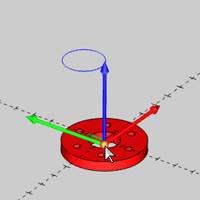
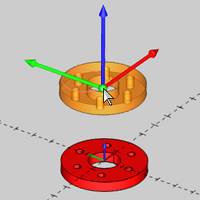
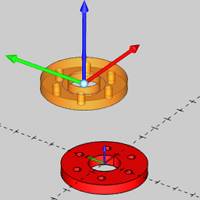
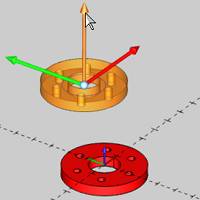
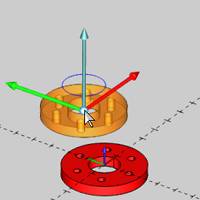
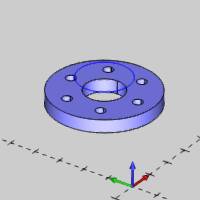
Dynamic Drawing
This function supports Dynamic Drawing which allows you to use a combination of sketching and data entry to create the entities. Prior to confirming the desired result in the function, an adjustable preview is visible. These previews can be modified using the sketch handles, data entry, or a combination of both. The benefit of Dynamic Drawing is that you can quickly utilized the sketch handles to adjust the size, placement, and, or, orientation to get the approximate result, and then use data entry to update to the exact values as needed.
|
Preview with Sketch Handles |
Final Entities |
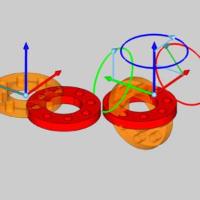
|
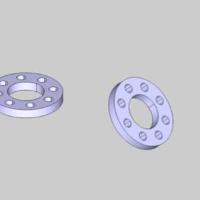
|
In the images above, we see the preview of the altered position / orientation of the entities which can be adjust with sketch handles, followed by those same entities after their positions / orientations are finalized.
Snap Increment
This function support the use of the snap increment when selecting the location of the entities. The snap increment allows you to get precise results when using mouse selection and helps to reduce data entry modifications.
To learn more, view Snap Increment.
Navigation
To open Translate:
- In the Move group, of the Utilities ribbon,click
 Translate.
Translate.
The parameters display in theData Entry Manager.
The Data Entry Parameters
|
|
|
| The list will display all entities currently selected for the function. | |
Translate Amount
The Translate Amount can be used to define the amount of movement in the X, Y, and Z axis.The Translate Amount will also show the amount of movement in the X, Y, and Z axis, when the Start Point, and End Point methods are used to set the amount of movement.
- X - amount of movement along the X axis.
- Y - amount of movement along the Y axis.
- Z - amount of movement along the Z axis.
Start Point
The Start Point determines where the geometry is moved from.You can use the list box to select the point, or you can enter coordinates in the X, Y, and Z fields below.
-
 Geometry Center - the geometry is translated, by the Translate Amount, from the center of the selected geometry.
Geometry Center - the geometry is translated, by the Translate Amount, from the center of the selected geometry. -
 Pick - allows you to select a point to move the geometry from.
Pick - allows you to select a point to move the geometry from.
|
|
|
| The list box will list the entity currently selected for the function. | |
-
X- determines the X-axis location of the start point of the translationmove in reference to the Active UCS.
-
Y- determines the Y-axis location of the start point of the translationmove in reference to the Active UCS.
-
Z- determines the Z-axis location of the start point of the translationmove in reference to the Active UCS.
End Point
The End Point determines where the geometry is moved to.You can use the list box to select the point, or you can enter coordinates in the X, Y, and Z fields below.
|
|
|
| This list box will show the entity currently selected for the function. | |
-
X- determines the X-axis location of the start point of the translationmove in reference to the Active UCS.
-
Y- determines the Y-axis location of the start point of the translationmove in reference to the Active UCS.
-
Z- determines the Z-axis location of the start point of the translationmove in reference to the Active UCS.
 Options
Options
- Copies - adds the specifiedamount of copies consecutively to the translated geometry insteadof only moving the original geometry.When using copy, the originalgeometry is not translated.
- Scale - scales thetranslated geometry by the amount typed in the Scale box.A valueof one equals no scaling and a value of 0.5 means fifty percent ofthe original size.The scale value can be adjusted by entering a value,or by adjusting the scale sketch handle that appears in the graphicsarea when the scale option is selected.
|
ScaleOff |
ScaleOn |
Click |
Drag |
|
|
|
|
|
-
 From Center- With this check box cleared,the selected geometry will scale from the WCS.This means that itsposition in the graphics area is scaled as well.
From Center- With this check box cleared,the selected geometry will scale from the WCS.This means that itsposition in the graphics area is scaled as well. From Center - Withthis check box selected, the selected geometry will scale from itsbounding center.This means that its position in the graphics areawill no be affected.
From Center - Withthis check box selected, the selected geometry will scale from itsbounding center.This means that its position in the graphics areawill no be affected. From Center
From Center
 From Center
From Center
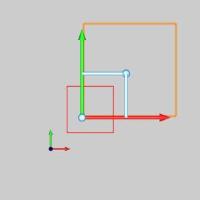
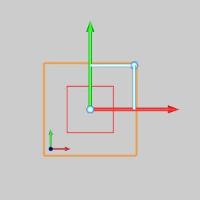
- OK - finalizes the function.
- Cancel - exits the function.
Quick Steps - Translate
- Open the function.
The Selected Geometry list automatically has focus. - Select all geometry to be translated.
The geometry is added to the Selected Geometry list.
The Start Point, and End Point values update to show the values for the Geometry Center, and a preview is shown. - Update the parameters to achieve the desired result, which will be shown by the preview.
The Preview updates as the values are updated. - With the values update to produce the intended result, as shown with the preview, click OK.
Note: When this feature is applied to solids, or surfaces, a CAD feature is added to the CAD Tree.
- Repeat as necessary.
Tip: Instead of applying features to solids and surfaces more than once, go to the CAD Tree to edit the existing feature. Since all solid and surface moves, and modifications are stored in the CAD Tree, editing a feature is preferable to adding many more to achieve the desired result. This will keep file size down and help ensure files don't become slow to respond.
- Click Cancel to close the function.






 (Delete All)
- removes all entities from the Selected Geometry list.
(Delete All)
- removes all entities from the Selected Geometry list.



